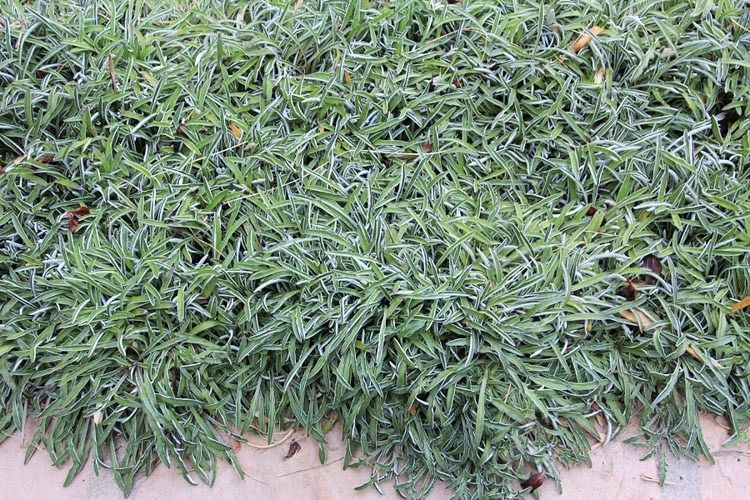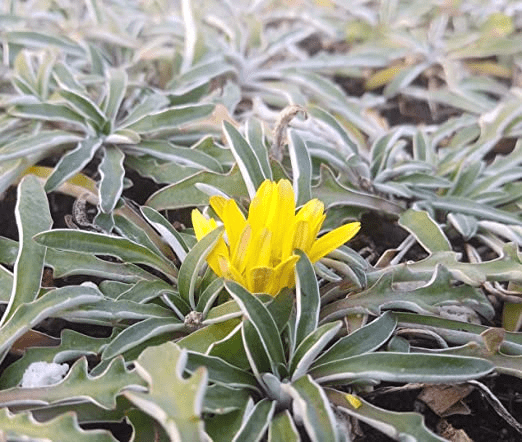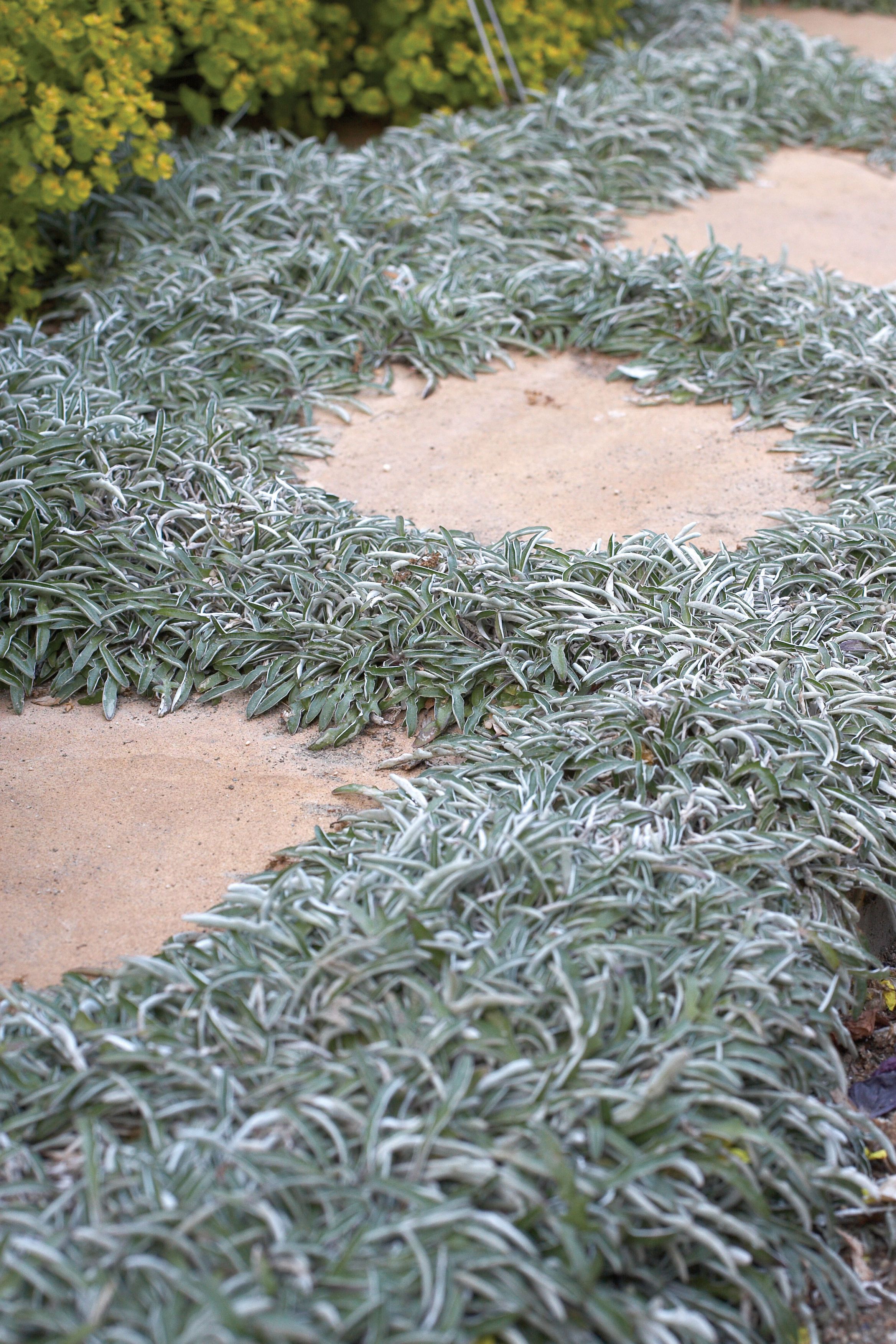The pursuit of sustainable alternatives to traditional lawn grass has led to a renaissance in ground cover plants. Many groundcovers are drought tolerant, water efficient, low maintenance, cost-effective, adaptable, durable, weed suppressors, and environmentally friendly.
There are many ground covers you can use on your lawn; among them is Dymondia, which is not only eco-friendly but also incredibly versatile. This hardy ground cover is a real contender in a gardener’s quest for an eco-friendly lawn.
In this guide, we’ll define Dymondia, explore its pros and cons, give tips for caring for it, and explain how to plant it.
What’s Dymondia?
Overview
- Botanical Name: Dymondia margaretae
- Plant Type: Perennial, Ground Cover
- Family: Asteraceae
- Size: 1-3 inches height and spread
- Hardiness zones: 9b-11
Dymondia also called Silver Carpet is a low-growing perennial plant native to South Africa’s coastal regions, which have sandy, well-drained soils. It features dense, silver-green foliage with white, fuzzy undersides, giving it a silvery appearance.
Dymondia forms a thick, carpet-like mat across the ground. In summer, Dymondia produces tiny, yellow, daisy-like flowers that bees visit regularly.
This eco-friendly plant is incredibly versatile. You can use it as a lush, low-maintenance lawn substitute, a filler between stepping stones, rock gardens, or even a decorative edging plant. It can handle light to moderate foot traffic, which makes it suitable for places like pathways.
It develops a deep root system so it can reach the moisture deep inside the soil. This also makes it excellent in preventing soil erosion, reducing the need for fertilizers, and suppressing weed growth. Dymondia grows best in full sun, and it can tolerate heat and some shade but is sensitive to frost (temperatures below 28°F can damage it).
Related Posts:
Pros And Cons Of Dymondia Lawn
Dymondia lawns are increasingly becoming popular because they offer several advantages. However, it also has some drawbacks. Below are the good and bad of a Dymondia lawn to help you decide whether it is a great fit for your lawn.
Pros Of Dymondia Lawn
1. Water Efficiency
Once established, a Dymondia can survive on minimal irrigation because this ground cover is highly drought-tolerant. Dymondia originates from a dry climate and develops deep, extensive roots that allow it to tap water deep in the soil.
A Dymondia lawn can live off rain. The evaporation rate on a Dymondia lawn is low because the dense mat it forms serves as a living mulch. A 1000-square-foot Dymondia lawn can save you up to $3500 on water bills yearly.
2. Low Maintenance
A Dymondia lawn is super easy to maintain. You rarely have to mow it, if you ever have to, because this plant grows very slowly, low, and remains tiny and uniform. Moreover, it thrives without fertilizers and forms a dense, tightly-knit mat that effectively suppresses weeds.
So, if you don’t want to spend much time and effort taking care of your lawn, switch to a Dymondia lawn.
3. Durability
Dymondia is tough as nails; it can easily handle abuse and harsh conditions like drought. Use it on areas you occasionally walk on because it can handle moderate foot traffic, but do not subject it to heavy traffic.
Dymondia can recover from damage caused by foot traffic. It also resists pests and diseases that often plague traditional lawns. Moreover, it is not susceptible to fungal infections. Also, as a perennial, Dymondia can live for several years.
3. Aesthetic Appeal
Picture a lush, verdant, soft ground cover that feels great to stroll on. This is what a Dymondia lawn offers. The subtle interplay of the green tops and silver undersides gives the leaves an attractive look. While the flowers aren’t showy or many, they are elegant and elevate the plant’s overall aesthetic.
A properly established Dymondia lawn is neat and covers the ground evenly without leaving bare spots or gaps. In warm climates, Dymondia stays green throughout the year.
4. Soil Improvement
Dymondia’s dense, deep roots help prevent erosion and stabilize the soil. They also create channels, thus enhancing aeration and water infiltration, which in turn improves soil structure.
5. Climate Adaptability
Dymondia is adaptable to challenging environments, thriving in dry and hot climates as well as coastal regions. It flourishes in areas whose summer temperatures exceed 90°F.
6. Biodiversity Support
This groundcover shelters small creatures like insects, spiders, earthworms, and beetles. In addition, its flowers attract pollinators.
7. Cost Effectiveness
Installing a Dymondia lawn might be expensive, but the money you save on water, fertilizers, pesticides, and mowing makes it worth it.
Cons Of Dymondia Lawn
i) Slow Establishment
It will take some time before your Dymondia lawn is fully established, so exercise patience during this period and water it consistently. Before you enjoy a mature, dense Dymondia lawn, it will look sparse, patchy, and seemingly unappealing to the eye.
ii) Intolerance To Heavy Foot Traffic
Dymondia isn’t suited for heavily trafficked lawn parts as it can disrupt its growth and cause physical damage through foliage bruising and breakage. Frequent foot traffic can make this ground cover thin and develop bare spots.
iii) Cold Sensitivity
If you grow Dymondia in a cold climate, you must protect it from frost because it can make this plant lose its foliage or become discolored.
How To Plant Dymondia Ground Cover
Follow these steps to establish this low-maintenance, environmentally friendly ground cover.
a) Choose and Prepare The Location
You can grow Dymondia on any soil (the best is sandy and loamy) as long as there is good drainage. Don’t plant it in places with poor drainage or standing water because Dymondia is susceptible to root rot. The place you choose should receive direct sunlight for 6 hours or longer daily.
Before planting Dymondia, clear any existing vegetation and loosen the soil. Also, consider adding organic matter to your lawn to enhance soil structure and fertility, but don’t use too much of it.
If your lawn soil has poor drainage, spread sand or gravel into the top layer. Alternatively, use soil mounds or create raised beds. Also, lightly apply a balanced, slow-release fertilizer and water the area until it’s moist but not waterlogged.
b) Plant Dymondia
The best time to plant Dymondia is spring or early fall in order to allow the plants to take root before summer or winter. You can plant Dymondia using plugs, seeds, or divisions.
Plugs and divisions are more common and reliable methods. Dig about 2-3 inches deep holes that are 6-12 inches apart and then gently place each Dymondia plug or division into its hole with the roots spread out. Carefully cover the holes with soil, but don’t bury the crowns of the plants.
Note
Spacing your Dymondia plants closely together results in faster coverage but is less economical.
c) Watering
After planting, water the Dymondia thoroughly to encourage good root-to-soil contact and help the soil settle. Water your Dymondias once or twice a week for the first six months. Reduce watering once your ground cover is established.
d) Mulching
Put 2 to 3 inches of organic mulch around your Dymondia plants to stop weeds and keep the ground moist. Do not pile mulch against the stems because it can lead to rotting. In addition, do not cover the leaves.
e) Fill In Any Gaps
Overseed the parts where Dymondia doesn’t fill in or plant additional plugs or divisions.
Tips for Caring for a Dymondia Lawn
These essential tips will help you keep your Dymondia attractive and healthy.
-
Water
We’ve already established that a Dymondia lawn doesn’t require much water to thrive. An occasional deep watering should suffice. Slightly increase the frequency during dry, hot spells.
In addition, monitor your lawn, watching out for signs of drought stress. These include leaves wilting or turning brown. Temporarily increase the number of times you water your plants to fix this problem.
-
Weed Control
Weeds won’t be much of an issue once your Dymondia lawn matures, but the same isn’t true during the establishment stage. So, keep an eye on your lawn during this period and pull any weeds you see. You can also use selective herbicides or organic weed control solutions.
-
Fertilizing
Dymondia isn’t a heavy or frequent feeder. Apply a balanced, slow-release fertilizer on your Dymondia lawn once a year at the start of the growing season.
-
Foot Traffic
Establish well-defined pathways to avoid stepping on Dymondia and delineate your lawn with edging materials. If necessary, remind people to avoid walking on it. Alternatively, surround your lawn with a fence or barrier.
-
Mowing
Trim your Dymondia lawn only when necessary, perhaps once or twice a year, to retain a tidy look. Set the mower high.
-
Thinning and Division
As your Dymondia lawn grows and matures, it can become too dense. Fix this by thinning it (dig out some of the plants to create more space between them).
You should also divide your Dymondias every 2-3 years or as needed. Remove a section of the Dymondia mat, cut it into smaller pieces, and replant it.
Summary
The benefits of Dymondia as lawn ground cover outweigh its potential drawbacks. Consider this beautiful plant for your landscape if you wish to reduce the amount of water that goes into your lawn, minimize yard work, and keep your outdoors visually interesting.

Hey there, I’m Derek Schew, a writer for Lawnholic.com, where we cover everything and anything related to lawns. As someone who’s spent countless hours tending to my own lawn, I’m passionate about sharing my knowledge and helping others achieve the perfect yard. From lawn care tips to product reviews, I’m committed to providing our readers with the most accurate and up-to-date information available. So whether you’re a seasoned lawn enthusiast or just getting started, I invite you to join our community and discover the joys of a lush, green lawn.



